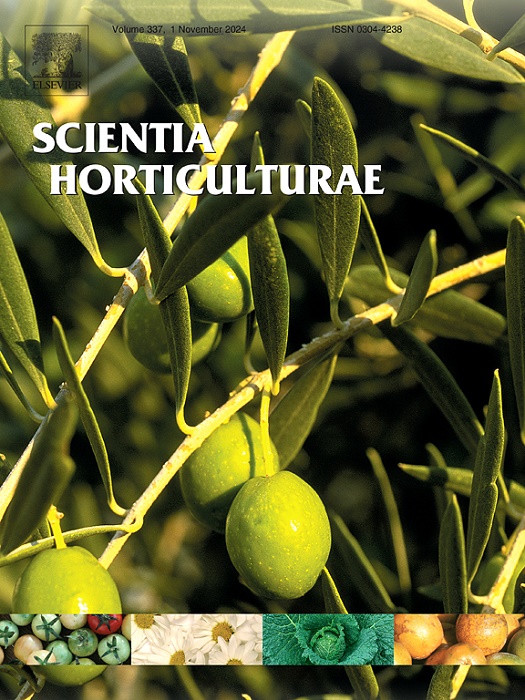转录组学和代谢组学分析揭示了冷链断裂加速猕猴桃采后成熟和类黄酮损失的机制
IF 3.9
2区 农林科学
Q1 HORTICULTURE
引用次数: 0
摘要
冷链系统对于保持猕猴桃和其他水果的质量和营养价值,以及促进其运输和供应至关重要。冷链断裂会对水果的品质和价值产生不利影响。因此,探索其代谢及分子基础研究对调控冷链断裂具有重要意义。本文比较了等温和冷链断裂对猕猴桃贮藏的影响,研究了猕猴桃的理化性质、代谢和转录组谱。代谢组学分析表明,黄酮类化合物是冷链断裂抑制的主要差异代谢物。此外,还鉴定了五个主要的生物标志物,以响应冷链断裂。转录组学和WGCNA分析表明,与低温相比,与乙烯合成和信号转导相关的大多数差异表达基因(ACS, ACOs, ETRs)以及淀粉和蔗糖代谢(BAMs, SPS, PFK, TPP)在冷链中断期间上调,而与类黄酮生物合成相关的DEGs (4CLs, CHI, F3'H)下调。此外,转录因子AcHsfA3a被发现与黄酮类化合物和鉴定的生物标志物相关。本研究为调控猕猴桃冷链断裂、提高果实品质、指导冷链运输提供理论依据。本文章由计算机程序翻译,如有差异,请以英文原文为准。

Transcriptomic and metabolomic analyses reveal the mechanism of cold chain breaks accelerate postharvest kiwifruit ripening and flavonoid loss
Cold chain systems are essential for preserving the quality and nutritional value of kiwifruit and other fruits, as well as facilitating their transportation and supply. Cold chain breaks can adversely affect fruit quality and value. Therefore, exploring its metabolism and molecular basis research is of great significance for regulating cold chain breaks. Herein, the effects of kiwifruit storage under isothermal and cold chain breaks were compared and its physicochemical properties, metabolism and transcriptome profiles were investigated. Metabolomic analyses revealed that flavonoids are the primary differential metabolites suppressed by cold chain breaks. Additionally, five main biomarkers were identified in response to cold chain breaks. Transcriptomic and WGCNA analyses demonstrated that the majority of differentially expressed genes associated with ethylene synthesis and signal transduction (ACS, ACOs, ETRs), as well as starch and sucrose metabolism (BAMs, SPS, PFK, TPP), were upregulated during cold chain disruptions compared to low temperatures, while DEGs related to flavonoid biosynthesis (4CLs, CHI, F3′H) were downregulated. Furthermore, transcription factor AcHsfA3a was found to be correlated with flavonoids and the identified biomarkers. This study provides a theoretical basis for regulating kiwifruit cold chain breaks, improving fruit quality, and guiding cold chain transportation.
求助全文
通过发布文献求助,成功后即可免费获取论文全文。
去求助
来源期刊

Scientia Horticulturae
农林科学-园艺
CiteScore
8.60
自引率
4.70%
发文量
796
审稿时长
47 days
期刊介绍:
Scientia Horticulturae is an international journal publishing research related to horticultural crops. Articles in the journal deal with open or protected production of vegetables, fruits, edible fungi and ornamentals under temperate, subtropical and tropical conditions. Papers in related areas (biochemistry, micropropagation, soil science, plant breeding, plant physiology, phytopathology, etc.) are considered, if they contain information of direct significance to horticulture. Papers on the technical aspects of horticulture (engineering, crop processing, storage, transport etc.) are accepted for publication only if they relate directly to the living product. In the case of plantation crops, those yielding a product that may be used fresh (e.g. tropical vegetables, citrus, bananas, and other fruits) will be considered, while those papers describing the processing of the product (e.g. rubber, tobacco, and quinine) will not. The scope of the journal includes all horticultural crops but does not include speciality crops such as, medicinal crops or forestry crops, such as bamboo. Basic molecular studies without any direct application in horticulture will not be considered for this journal.
 求助内容:
求助内容: 应助结果提醒方式:
应助结果提醒方式:


